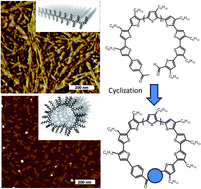Macrocyclic non-collapsible p-conjugated structures are known to be useful in the preparation of 1D nanotubes, 2D porous networks and 3D inclusion complexes through either unique p–p stacking or concave–convex interactions. In particular for medium to giant cyclic structures, i.e. larger than 2 nm in diameter, the p-conjugated system allows benzene, thiophene, pyridine and acetylene-based macrocycles to exhibit peculiar optical, electronic, and self-assembly properties compared to their linear homologues. Structures with fully conjugated p-systems are particularly appealing because of the absence of edge effects in the p-system due to chain ends. To date, only a few examples of fully conjugated cyclic periphery have been reported. Among those, several kinds of macrocyclic oligothiophenes have attracted considerable attention since such macrocycles exhibit interesting electronic properties such as non-linear optical effects.
In this study, Coulembier and co-workers have demonstrated that the preparation of giant regioregular poly(3-hexylthiophene) (P3HT) cyclics is possible with a simple but unperfected aldol reaction from a pre-formed telechelic P3HT. The four-step synthetic strategy is based on a non-metallic aldol cyclization of a designed Luscombe-type regioregular P3HT. AFM analyses highlight that linear and macrocyclic P3HTs give different self-assembled nanostructures. Interestingly, the tubular assembly of the macrocyclic P3HT, with an estimated diameter of 5 nm, could be exploited to incorporate nano-sized structures such as carbon nanotubes or fullerenes, with potential application as a compatibilizer for bulk heterojunction photovoltaic diodes for instance.
Macrocyclic regioregular poly(3-hexylthiophene): from controlled synthesis to nanotubular assemblies by Olivier Coulembier, Gaelle Deshayes, Mathieu Surin, Julien De Winter, Florian Boon, Cecile Delcourt, Philippe Leclere, Roberto Lazzaroni, Pascal Gerbaux and Philippe Dubois, Polym. Chem., 2013, 4, 237-241.
Julien Nicolas is a guest web-writer for Polymer Chemistry. He currently works at Univ. Paris-Sud (FR) as a CNRS researcher











